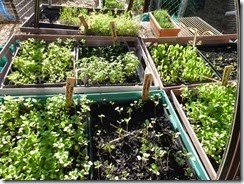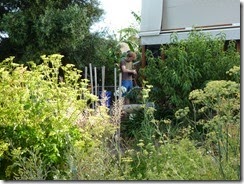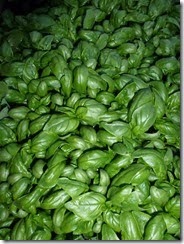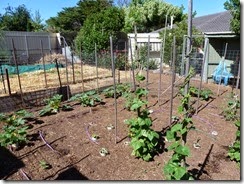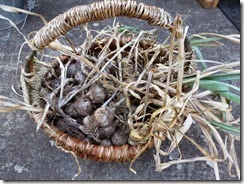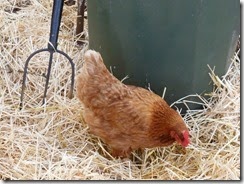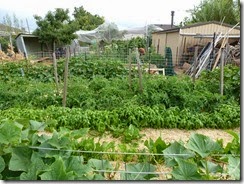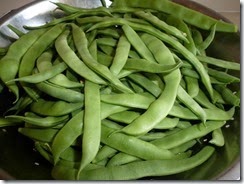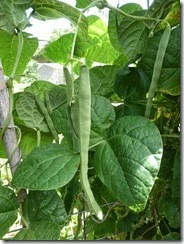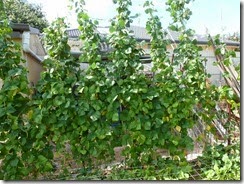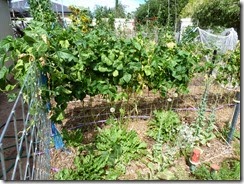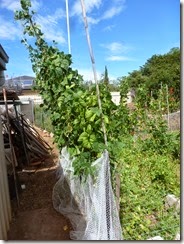It’s autumn in southern Australia and plants are beginning to slow down as soil temperatures fall and daylight hours rapidly drop away. All this starts once Easter is over and the first rains bring the soil back to life; the autumn chill is coming.
Only a month ago I was protecting seedlings against too much sun and heat. Shade cloth over new seedlings produced the worst seed table I can recall in a very long time. One week they were thriving (photo on the right) and then – phlat!
The most likely problem is that the commercial ‘premium’ potting mix I used lacked sufficient nutrients to provide these seedlings with the energy they needed to cope with extremes of heat and shading, no matter how carefully I watered them. So what started out as excellent piece of planning – an early start to the autumn plantings – turned into a near-disaster, with many seedlings lost.
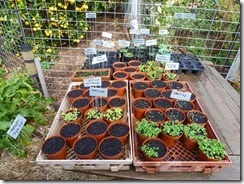 So the seed table was moved to a sunnier spot, new potting mix obtained from a more reputable supplier, and new seeds planted. All the usual winter stuff - red, brown and white onions, orange and purple carrots, kohl rabi, beetroot, parsley, tatsoi, whitlof, all sorts of flowers (for the Spring display), mitsuba, mitzuna, filderspitzkraut, chives, garlic chives, Black Spanish and Miyashiga White radishes, raddichio, endives, ‘Fat Hen’ salad greens, ‘Freckles’ cos lettuce and thyme.
So the seed table was moved to a sunnier spot, new potting mix obtained from a more reputable supplier, and new seeds planted. All the usual winter stuff - red, brown and white onions, orange and purple carrots, kohl rabi, beetroot, parsley, tatsoi, whitlof, all sorts of flowers (for the Spring display), mitsuba, mitzuna, filderspitzkraut, chives, garlic chives, Black Spanish and Miyashiga White radishes, raddichio, endives, ‘Fat Hen’ salad greens, ‘Freckles’ cos lettuce and thyme.
 More netting is dragged out of the shed to cover these seed trays before the blackbirds get in there and flick up the potting mix in their search for worms; the fragile seedlings are all too easily buried.
More netting is dragged out of the shed to cover these seed trays before the blackbirds get in there and flick up the potting mix in their search for worms; the fragile seedlings are all too easily buried.
The ‘home paddock’ garden bed has been dormant all summer for lack of available water; this has been mulched and watered and the soil restarted to receive these autumn/winter crops and the remnants of the summer seedlings.
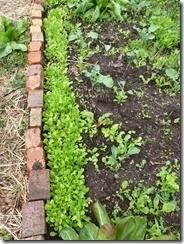 April brings the first serious rains we’ve had in over six months; weeds and remnant vegetable seeds spring up all though this soil. Direct-sown lettuce does particularly well, along with broccoli, cauliflower, ‘rapa’, silverbeet and corn salad (‘Feldsalat’ in German). It doesn’t look like much now, but it will all get sorted before the soil cools too far.
April brings the first serious rains we’ve had in over six months; weeds and remnant vegetable seeds spring up all though this soil. Direct-sown lettuce does particularly well, along with broccoli, cauliflower, ‘rapa’, silverbeet and corn salad (‘Feldsalat’ in German). It doesn’t look like much now, but it will all get sorted before the soil cools too far.
All this goes on while the last of the summer crops are harvested – pumpkins, zucchinis, basil, eggplants (aubergines), capsicums (peppers), beans, avocadoes, grapes and peaches. The citrus trees – mandarins, grapefruit, oranges and lemons – are already starting to show colour.
And the current soil temperature? Over in the production garden soil temperature is monitored automatically and continuously. I need only log onto the internet to see that the long slow slide into winter is upon us. So now it is a race to get those seed-table seedlings to a sufficient size to plant them out before cool soils stop them altogether.

